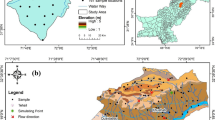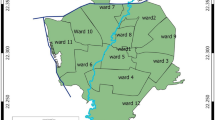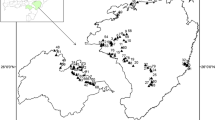Abstract
Fluoride (F) contamination in groundwater can be problematic to human health. This study evaluated the concentration of fluoride in groundwater resources of Isfahan Province, the central plateau of Iran, and its related health issues to the inhabitant populations. For this purpose, 573 drinking groundwater samples were analyzed in 2016 by using the spectrophotometric method. Non-carcinogenic health risks due to F exposure through consumption of drinking water were assessed using the US EPA method. In addition, the associated zoning maps of the obtained results were presented using geographic information system (GIS). The results indicated that F content in drinking water ranged from 0.02 to 2.8 mg/L. The F contents were less than 0.50 mg/L in 63% of the drinking groundwater samples, 0.51–1.5 mg/L in 33.15%, and higher than 1.5 mg/L in 3.85% (Iran and World Health Organization guidelines) of the drinking groundwater samples. The F levels in the west and the south groundwater resources of the study areas were lower than 0.5 mg/L, which is within the recommended values for controlling dental caries (0.50–1.0 mg/L). Therefore, these places require more attention and more research is needed to increase F intake for health benefit. The HQ index for children, teens and male and female adults had health hazards (HQ > 1) in 51, 17, 28, and 18 of samples, respectively. Groundwater resources having a risk of more than one were located in the counties of Nayin, Natanz, and Ardestan. So, in these areas, there are potential risks of dental fluorosis. The most vulnerable groups were children. The F levels must be reduced in this region to decrease endemic fluorosis.






Similar content being viewed by others
References
Aghaei, M., Derakhshani, R., Raoof, M., Dehghani, M., & Mahvi, A. H. (2015). Effect of fluoride in drinking water on birth, height and weight: an ecological study in Kerman Province, Zarand County, Iran. Fluoride, 48, 160–168.
Antonijevic, E., Mandinic, Z., Curcic, M., Djukic-Cosic, D., Milicevic, N., Ivanovic, M., Carevic, M. & Antonijevic, B. 2016. “Borderline” fluorotic region in Serbia: correlations among fluoride in drinking water, biomarkers of exposure and dental fluorosis in schoolchildren. Environmental geochemistry and health, 38, 885-896.
APHA. (2005). Standard Methods for the Examination of Water and Wastewater, 21st ed (pp. 1220). Washington DC: American Public Health Association.
Augustsson, A., & Berger, T. (2014). Assessing the risk of an excess fluoride intake among Swedish children in households with private wells—expanding static single-source methods to a probabilistic multi-exposure-pathway approach. Environment International, 68, 192–199. https://doi.org/10.1016/j.envint.2014.03.014.
Ayoob, S., & Gupta, A. K. (2006). Fluoride in drinking water: a review on the status and stress effects. Critical Reviews in Environmental Science and Technology, 3 6(6), 433–487. https://doi.org/10.1080/10643380600678112.
Barnes, D. G., Dourson, M., Preuss, P., Bellin, J., Derosa, C., Engler, R., Erdreich, L., Farber, T., Fenner-Crisp, P., & Francis, E. (1988). Reference dose (RfD): description and use in health risk assessments. Regulatory Toxicology and Pharmacology, 8(4), 471–486. https://doi.org/10.1016/0273-2300(88)90047-5.
Bhattacharya, P., Lesafi, F., Filemon, R., Ligate, F., Ijumulana, J. & Mtalo, F. (2016). Geogenic fluoride and arsenic contamination in the groundwater environments in Tanzania. EGU General Assembly Conference Abstracts, 18, 16677.
Battaleb-Looie, S., Moore, F., Malde, M., & Jacks, G. (2013). Fluoride in groundwater, dates and wheat: estimated exposure dose in the population of Bushehr, Iran. Journal of Food Composition and Analysis, 29(2), 94–99. https://doi.org/10.1016/j.jfca.2012.08.001.
Bo, Z., Mei, H., Yongsheng, Z., Xueyu, L., Xuelin, Z., & Jun, D. (2003). Distribution and risk assessment of fluoride in drinking water in the west plain region of Jilin province, China. Environmental Geochemistry and Health, 25(4), 421–431. https://doi.org/10.1023/B:EGAH.0000004560.47697.91.
Chavoshi, E., Afyuni, M., Hajabbasi, M., Khoshgoftarmanesh, A., Abbaspour, K., Shariatmadari, H., & Mirghafari, N. (2011). Health risk assessment of fluoride exposure in the soil, plants, and water at Isfahan, Iran. Human and Ecological Risk Assessment, 17(2), 414–430. https://doi.org/10.1080/10807039.2011.552397.
Chen, J., Wu, H., Qian, H., & Gao, Y. (2017). Assessing nitrate and fluoride contaminants in drinking water and their health risk of rural residents living in a semiarid region of northwest China. Exposure and Health, 9(3): 183-95. https://doi.org/10.1007/s12403-016-0231-9.
Chuah, C. J., Lye, H. R., Ziegler, A. D., Wood, S. H., Kongpun, C., & Rajchagool, S. (2016). Fluoride: a naturally-occurring health hazard in drinking-water resources of Northern Thailand. The Science of the Total Environment, 545, 266–279.
Das, K., & Mondal, N. K. (2016). Dental fluorosis and urinary fluoride concentration as a reflection of fluoride exposure and its impact on IQ level and BMI of children of Laxmisagar, Simlapal Block of Bankura District, W.B., India. Environmental Monitoring and Assessment, 188(4), 218. https://doi.org/10.1007/s10661-016-5219-1.
Dindarloo, K., Jamali, H. A., Lakbala, P., Valizade, H., Azad, M., & Mahmodi, H. (2016). Determination of fluoride concentration in drinking water and its relation with DMFT: a case study in Hormozgan, Iran. Journal of Basic Research in Medical Sciences, 3, 28–36.
Do, L., Ha, D., Peres, M. A., Skinner, J., Byun, R., & Spencer, A. J. (2017). Effectiveness of water fluoridation in the prevention of dental caries across adult age groups. Community Dentistry and Oral Epidemiology, 45(3):225–232.
EPA (1989). Risk Assessment Guidance for Superfund Volume I: Human Health Evaluation Manual (Part A) (pp. 20450). Washington, DC: Office of Emergency and Remedial Response U.S. Environmental Protection Agency. http://www.epa.gov/swerrims/riskassessment/risk_superfund.html. Accessed 31 August 2017.
EPA (2004). Risk Assessment Guidance for Superfund Volume I: Human Health Evaluation Manual (Part E, Supplemental Guidance for Dermal Risk Assessment) Final. Washington, DC: Office of Superfund Remediation and Technology Innovation U.S. Environmental Protection Agency. https://www.epa.gov/risk/risk-assessment-guidance-superfund-rags-part-e. Accessed 31 August 2017.
EPA (2011). The United States Environmental Protection Agency. EPA 635/R-03/007. http://www.epa.gov/iris. In support of summary information on the Integrated Risk Information System (IRIS). Exposure factors handbook 2011 edition (Final). Washington, DC: Chapter 8―Body Weight Studies.
Erdal, S., & Buchanan, S. N. (2005). A quantitative look at fluorosis, fluoride exposure, and intake in children using a health risk-assessment approach. Environmental Health Perspectives, 113(1), 111–117.
Fordyce, F., Vrana, K., Zhovinsky, E., Povoroznuk, V., Toth, G., Hope, B., Iljinsky, U., & Baker, J. (2007). A health risk assessment for fluoride in Central Europe. Environmental Geochemistry and Health, 29(2), 83–102. https://doi.org/10.1007/s10653-006-9076-7.
Gao, H. J., Jin, Y. Q., & Wei, J. L. (2013). Health risk assessment of fluoride in drinking water from Anhui Province in China. Environmental Monitoring and Assessment, 185(5), 3687–3695. https://doi.org/10.1007/s10661-012-2820-9.
Goodarzi, F., Mahvi, A. H., Hosseini, M., Nodehi, R. N., Kharazifard, M. J., & Parvizishad, M. (2016). Fluoride concentration of drinking water and dental fluorosis: a systematic review and meta-analysis in Iran. Dental Hypotheses, 7, 81.
Goodarzi, F., Mahvi, A. H., Hosseini, M., Nodehi, R. N., Kharazifard, M. J., & Parvizishad, M. (2017). Prevalence of dental caries and fluoride concentration of drinking water: a systematic review. Dental Research Journal, 14, 163.
Guissouma, W., Hakami, O., Al-Rajab, A. J., & Tarhouni, J. (2017). Risk assessment of fluoride exposure in drinking water of Tunisia. Chemosphere, 177, 102–108. https://doi.org/10.1016/j.chemosphere.2017.03.011.
Harrison, P. T. (2005). Fluoride in water: a UK perspective. Journal of Fluorine Chemistry, 126(11-12), 1448–1456. https://doi.org/10.1016/j.jfluchem.2005.09.009.
Hassell, T. M., & Harris, E. L. (1995). Genetic influences in caries and periodontal diseases. Critical Reviews in Oral Biology & Medicine, 6(4), 319–342. https://doi.org/10.1177/10454411950060040401.
Hillier, S., Inskip, H., Coggon, D., & Cooper, C. (1996). Water fluoridation and osteoporotic fracture. Community Dental Health, 13, 63–68.
Huang, D., Yang, J., Wei, X., Qin, J., Ou, S., Zhang, Z. & Zou, Y. (2017). Probabilistic risk assessment of Chinese residents' exposure to fluoride in improved drinking water in endemic fluorosis areas. Environmental Pollution, 222, 118–125. https://doi.org/10.1016/j.envpol.2016.12.074.
Indermitte, E., Savva, A., & Karro, E. (2009). Exposure to high fluoride drinking water and risk of dental fluorosis in Estonia. International Journal of Environmental Research and Public Health, 6(2), 710–721. https://doi.org/10.3390/ijerph6020710.
Irigoyen-Camacho, M., Pérez, A. G., González, A. M., & Alvarez, R. H. (2016). Nutritional status and dental fluorosis among schoolchildren in communities with different drinking water fluoride concentrations in a central region in Mexico. The Science of the Total Environment, 541, 512–519. https://doi.org/10.1016/j.scitotenv.2015.09.085.
IRIS (2016). Integrated Risk Information System, Fluorine (Soluble Fluoride). https://cfpub.epa.gov/ncea/iris2/chemicalLanding.cfm?substance_nmbr¼53. Accessed 16 July 2016.
Karinnzade, S., Aghaei, M., & Mahvi, A. H. (2014). IQ of 9-12-year-old chldren in high-and low-drinking water fluoride areas in west azerbaijan province, Iran: further information on the two villages in the study and the confounding factors considered. Fluoride, 47, 266–271.
Kasim, M., & Choudhary, A. (2017). Long-term effects due to high fluoride concentration in drinking water and socio-economic status of the rural population in district pale, rajasthan: a case study. Journal of Global Biosciences, 6, 4689–4694.
Keshavarz, S., Ebrahimi, A., & Nikaeen, M. (2015). Fluoride exposure and its health risk assessment in drinking water and staple food in the population of Dayyer, Iran, in 2013. Journal of Education and Health Promotion, 4, 72.
KheradPisheh, Z., Ehrampoush, M., Montazeri, A., Mirzaei, M., Mokhtari, M., & Mahvi, A. (2016). Fluoride in drinking water in 31 provinces of Iran. Exposure and Health, 8(4), 465–474. https://doi.org/10.1007/s12403-016-0204-z.
Kut, K. M. K., Sarswat, A., Srivastava, A., Pittman, C. U., & Mohan, D. (2016). A review of fluoride in African groundwater and local remediation methods. Groundwater for Sustainable Development, 2, 190–212.
Li, Y., Liang, C., Slemenda, C. W., Ji, R., Sun, S., Cao, J., Emsley, C. L., Ma, F., Wu, Y., & Ying, P. (2001). Effect of long-term exposure to fluoride in drinking water on risks of bone fractures. Journal of Bone and Mineral Research, 16(5), 932–939. https://doi.org/10.1359/jbmr.2001.16.5.932.
Means, B. 1989. Risk-assessment guidance for superfund. Volume 1. Human health evaluation manual. Part A. Interim report (Final). Environmental Protection Agency, Office of Solid Waste and Emergency Response, Washington, DC.
Nabavi, S. M., Nabavi, S. F., Eslami, S., & Moghaddam, A. H. (2012). In vivo protective effects of quercetin against sodium fluoride-induced oxidative stress in the hepatic tissue. Food Chemistry, 132(2), 931–935. https://doi.org/10.1016/j.foodchem.2011.11.070.
Näsman, P., Granath, F., Ekstrand, J., Ekbom, A., Sandborgh-Englund, G., & Ford, C. M. (2016). Natural fluoride in drinking water and myocardial infarction: a cohort study in Sweden. The Science of the Total Environment, 562, 305–311. https://doi.org/10.1016/j.scitotenv.2016.03.161.
Newton, J. N., Verne, J., Dancox, M., & Young, N. (2017). ‘Are fluoride levels in drinking water associated with hypothyroidism prevalence in England? A large observational study of GP practice data and fluoride levels in drinking water’: comments on the authors’ response to earlier criticism. Journal of Epidemiology and Community Health, 71(4), 315–316. https://doi.org/10.1136/jech-2016-208649.
Nouri, J., Mahvi, A. H., Babaei, A., & Ahmadpour, E. (2006). Regional pattern distribution of groundwater fluoride in the Shush aquifer of Khuzestan County, Iran. Fluoride, 39, 321.
Omid, N., Maguire, A., O'Hare, W. T., & Zohoori, F. V. (2017). Total daily fluoride intake and fractional urinary fluoride excretion in 4-to 6-year-old children living in a fluoridated area: weekly variation? Community Dentistry and Oral Epidemiology, 45(1), 12–19. https://doi.org/10.1111/cdoe.12254.
Oruc, N. (2008). Occurrence and problems of high fluoride waters in Turkey: an overview. Environmental Geochemistry and Health, 30(4), 315–323. https://doi.org/10.1007/s10653-008-9160-2.
Ozsvath, D. L. (2009). Fluoride and environmental health: a review. Reviews in Environmental Science and Bio/Technology, 8(1), 59–79. https://doi.org/10.1007/s11157-008-9136-9.
Patterson, J., Hakkinen, P. B., & Wullenweber, A. E. (2002). Human health risk assessment: selected Internet and World Wide Web resources. Toxicology, 173(1–2), 123–143. https://doi.org/10.1016/S0300-483X(02)00027-6.
Rahmani, A., Rahmani, K., Dobaradaran, S., Mahvi, A. H., Mohamadjani, R., & Rahmani, H. (2010). Child dental caries in relation to fluoride and some inorganic constituents in drinking water in Arsanjan, Iran. Fluoride, 43, 179–186.
Raj, D., & Shaji, E. (2017). Fluoride contamination in groundwater resources of Alleppey, southern India. Geoscience Frontiers, 8(1), 117–124. https://doi.org/10.1016/j.gsf.2016.01.002.
Rasool, A., Xiao, T., Baig, Z. T., Masood, S., Mostafa, K. M., & Iqbal, M. (2015). Co-occurrence of arsenic and fluoride in the groundwater of Punjab, Pakistan: source discrimination and health risk assessment. Environmental Science and Pollution Research, 22(24), 19729–19746. https://doi.org/10.1007/s11356-015-5159-2.
Salve, P., Maurya, A., Kumbhare, P., Ramteke, D., & Wate, S. (2008). Assessment of groundwater quality with respect to fluoride. Bulletin of Environmental Contamination and Toxicology, 81(3), 289–293. https://doi.org/10.1007/s00128-008-9466-x.
Shaji, E., Viju, J., & Thambi, D. (2007). High fluoride in groundwater of Palghat District, Kerala. Current Science, 92, 240–245.
Shyam, R., & Kalwania, G. (2012). Health risk assessment of fluoride with other parameters in ground water of Sikar city (India). Environmental Earth Sciences, 65(4), 1275–1282. https://doi.org/10.1007/s12665-011-1375-3.
Sun, L., Gao, Y., Liu, H., Zhang, W., Ding, Y., Li, B., Li, M., & Sun, D. (2013). An assessment of the relationship between excess fluoride intake from drinking water and essential hypertension in adults residing in fluoride endemic areas. Science of the Total Environment, 443, 864–869. https://doi.org/10.1016/j.scitotenv.2012.11.021.
Susheela, A., Bhatnagar, M., Vig, K., & Mondal, N. (2005). Excess fluoride ingestion and thyroid hormone derangements in children living in Delhi, India. Fluoride, 38, 98–108.
Tejaswi, S. K., Shetty, S., Annapoorna, B., Pujari, S. C., Reddy, S. & Nandlal, B. 2013. A pioneering study of dental fluorosis in the libyan population. Journal of international oral health: JIOH, 5, 67.
Tiwari, A. K., Singh, A. K., & Mahato, M. K. (2017). GIS-based evaluation of fluoride contamination and assessment of fluoride exposure dose in groundwater of a district in Uttar Pradesh, India. Human and Ecological Risk Assessment: An International Journal, 23(1), 56–66. https://doi.org/10.1080/10807039.2016.1220824.
Trivedi, M., Verma, R., Chinoy, N., Patel, R., & Sathawara, N. (2007). Effect of high fluoride water on intelligence of school children in India. Fluoride, 40, 178–183.
US EPA. (2000). Risk-based concentration table. Washington, DC: Office of Health and Environmental Assessment.
Valdez-Jiménez, L., Fregozo, C. S., Beltrán, M. M., Coronado, O. G., & Vega, M. P. (2011). Effects of the fluoride on the central nervous system. Neurología (English Edition), 26(5), 297–300. https://doi.org/10.1016/S2173-5808(11)70062-1.
Wasana, H. M., Perera, G. D., Gunawardena, P. D. S., Fernando, P. S., & Bandara, J. (2017). WHO water quality standards vs synergic effect (s) of fluoride, heavy metals and hardness in drinking water on kidney tissues. Scientific Reports, 7, 42516. https://doi.org/10.1038/srep42516.
WHO (2004). World Health Organization Guidelines for drinking-water quality, World Health Organization. Third Edition, Vol 1. Recommendations, Geneva.
Xiong, X., Liu, J., He, W., Xia, T., He, P., Chen, X., Yang, K. & Wang, A. (2007). Dose-effect relationship between drinking water fluoride levels and damage to liver and kidney function s in children. Environmental Research, 103(1), 112-116. https://doi.org/10.1016/j.envres.2006.05.008.
Yeung, C. A. (2008). A systematic review of the efficacy and safety of fluoridation. Evidence-Based Dentistry, 9(2), 39–43. https://doi.org/10.1038/sj.ebd.6400578.
Zabin, S. A., Foaad, M., & Al-Ghamdi, A. Y. (2008). Non-carcinogenic risk assessment of heavy metals and fluoride in some water wells in the Al-Baha Region, Saudi Arabia. Human and Ecological Risk Assessment, 14(6), 1306–1317. https://doi.org/10.1080/10807030802494667.
Acknowledgements
This paper is a part of an approved MSc Thesis (#395894). The authors acknowledge funding provided by the Isfahan University of Medical Science, School of Health. The help and cooperation of rural Isfahan Water & Wastewater Company are also appreciated.
Author information
Authors and Affiliations
Corresponding author
Rights and permissions
About this article
Cite this article
Aghapour, S., Bina, B., Tarrahi, M.J. et al. Distribution and health risk assessment of natural fluoride of drinking groundwater resources of Isfahan, Iran, using GIS. Environ Monit Assess 190, 137 (2018). https://doi.org/10.1007/s10661-018-6467-z
Received:
Accepted:
Published:
DOI: https://doi.org/10.1007/s10661-018-6467-z




